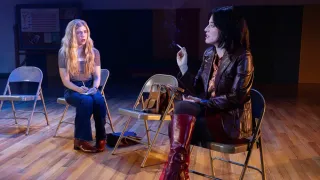November 8, 2023
Queering Cinema: Women in (Sci-Fi) Trouble
Robert Nesti READ TIME: 7 MIN.
"I'm still alive," actress Sean Young told the New York Times in a recent interview. Why Young was being so forthright about her mortality may be because she has largely fallen out of sight in the years since she was a Hollywood ingenue in the 1980s. But, as she has pointed out in a number of interviews, she has continued to work since her celebrity-generating roles in "Bladerunner" and "No Way Out," carving out a career in various less well-known projects as she raised a family in Arizona.
What has brought Young to the forefront this week is her starring role in the off-Broadway play "Ode to a Wasp Woman" in which she tells the life of (amongst others) the tragic B-movie star Susan Cabot who starred in the original "The Wasp Woman" in 1959. The other celebrities Young chronicles are George 'Superman' Reeves, Barbara Payton, Alfalfa Switzer.
To the Times Young said she had never seen "The Wasp Woman" when the play by Rider McDowell came her way. "For this, I watched it all the way through. It's pretty cheesy, but I wanted to make sure I knew who she was. She had a great face," she explained.
In the 1950s, Cabot worked in television, theater, and in B-movies with "The Wasp Woman" being her most famous role. After filming it, she went into seclusion, living off of investments as her mental health deteriorated. In December 1986, she was bludgeoned to death by her 22-year-old son.
Did she think Cabot was a tragic figure? "Well, her son murdered her. That's tragic," she told the Times.
"That's at the top of the list. But her dad left her before her first birthday, and her mother was placed in an insane asylum. Show business might have been the thing that offered her any self-confidence. That was the one thing that had meaning for her. Maybe her career was the one moment where she might have felt like, 'I'm somebody.' There's a line in the script: 'I came from nothing. From less than nothing where people laughed at my dreams.' So she's pretty messed up."
As is her character in "The Wasp Woman," an aging owner of a pharmaceutical company who sets out to find a solution that could reverse the aging process. She finds one, but its deadly side effect is to turn her into a giant wasp. The result is a camp classic – one of a group of sci-fi films of women in (sci-fi) trouble. Each's campiness alone makes them great candidates for queer cinema.
The Wasp Woman
Following the success of "The Fly" a year before, schlock-master Roger Corman did his low-budget version by reversing the sexes. Susan Cabot stars as an aging beauty product magnate Janice Starlin who hires a controversial scientist who is researching wasps with hopes of finding a serum that would reverse aging. Cabot takes the experimental drug and becomes a blood-sucking beast with the head of an insect and the body of a human. To achieve the effect of a blood-sucking beast, Cabot wore an insect mask and squirted chocolate sauce in her mouth, which when photographed in black-and-white appeared as blood during her blood-sucking sequences. Shot in two weeks for $50,000, the film suffers from poor continuity and cheesy special effects. But at the film's heart is a commentary on the women aging in contemporary America. If Cabot's character were a man, they would not face the same pressures that she faces here – Cabot needs to be young and beautiful to be successful in her business, which wouldn't be true for a man in her position.
The Attack of the 50-Foot Woman
In the late 1950s, Corman all but invented a new movie demographic – teenagers craving for cheap thrills – and he delivered with his series of B-movies that would play on double-bills. Others picked up on the formula and one of the more successful (and hilarious) was "The Attack of the 50 Foot Woman," the 1958 low-budget sci-fi epic that was perfect drive-in fare. It was even made with drive-in money from producers who ran a successful drive-in chain in the American South post World War II. Made in just 8 days at a cost of $89,000, the film is famous for its poorly-rendered special effects, which makes its giant creatures transparent in its process shots. And for its spectacular performance by Allison Hayes as the unhinged socialite with a straying husband and a drinking problem, who grows into a giant after an encounter with a space alien. This makes for high camp fare, but as Tony Williams writes in the journal Science Fiction Studies, the film "anticipates the concerns about aspects of female oppression more fully articulated a decade later in the Women's Liberation Movement. The film's latent content has the heroine a victim of sexual and economic oppression." Williams contends that Hayes "emerges as a figure of excess, a monstrous figure threatening patriarchal institutions and one who must, therefore, leave the frame."
The Astounding She Monster
This B-sci-fi epic has a great title, a statuesque creature, and a twist ending. In it a gang of kidnappers make the mistake of hiding out in a cabin near where they are stalked by a mysterious alien, who appears as a tall woman in high heels with some serious eyebrows dressed in a tight-fitting space outfit. Heavily contaminated with radiation, she kills everything she touches. Critic Paul Meehan wrote of the film: "There's absolutely nothing astounding about 'The Astounding She-Monster' unless it's how astoundingly bad the movie is. Director Ashcroft employs static wide shots in most scenes, with little in the way of dynamic editing to enliven the action. The acting and screenplay are pedestrian, and while the alien femme fatale might have been made into an intriguing, complex character, she is rendered mute and reduced to a homicidal cipher." Making the creature such a toxic threat also undermined the film's ending, in which it is revealed that the creature is peace emissary from an alien culture. If she came in peace, why was she so lethal?
Tormented
The victimized woman in this hugely entertaining supernatural story is Vi, a lounge singer murdered by boyfriend Tom Stewart, a social climbing jazz musician who murders her when she becomes a roadblock to his upcoming marriage to a socialite. Tom's problem is that Vi doesn't stay dead, appearing at times as a huge floating head that only Tom can see. "Tormented" follows in the steps of films by schlockmeister William Castle with its mix of the psychological and supernatural, but it is the loony direction (by Bert I. Gordon) and over-the-top performances that make "Tormented" such camp fun. Best of all is Juli Reding as the murdered lounge singer who just won't go away and appears at the least opportune moment. It also boasts a surprisingly nuanced jazz score by Albert Glasser, which was later rediscovered and released on CD.
The Birds
Not quite as camp as the other titles on this list, Alfred Hitchcock's 1963 thriller, does contain one of the most camp images in modern cinema: mink-clad Tippi Hedren navigates a rowboat as she plays a game of hide-and-seek with lawyer Rod Taylor only to be smacked by a seagull in what is a portent of what's to follow. Hitchcock's film is both a doomsday thriller and a rather cruel account of the disintegration of woman's personality. Filming of the climatic bird attack nearly destroyed Hedren as well, causing her to be hospitalized after the grueling week-long shooting of the sequence. At the film's end, Melanie has been traumatized to a point where she may never recover, nor may the world as massive groups of birds rest before their next attack.






